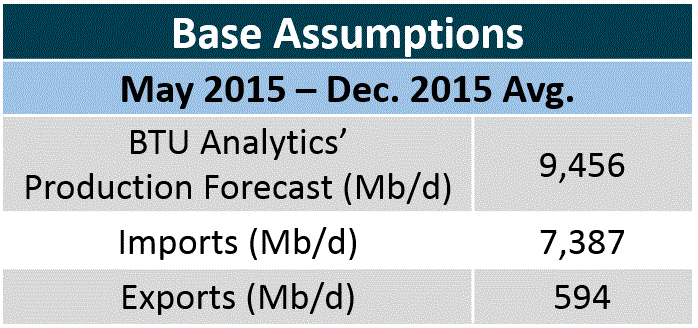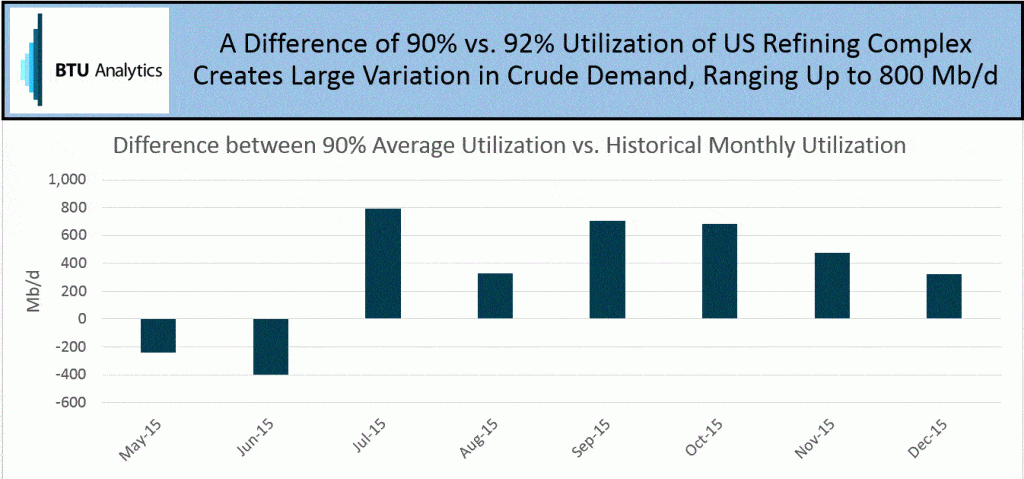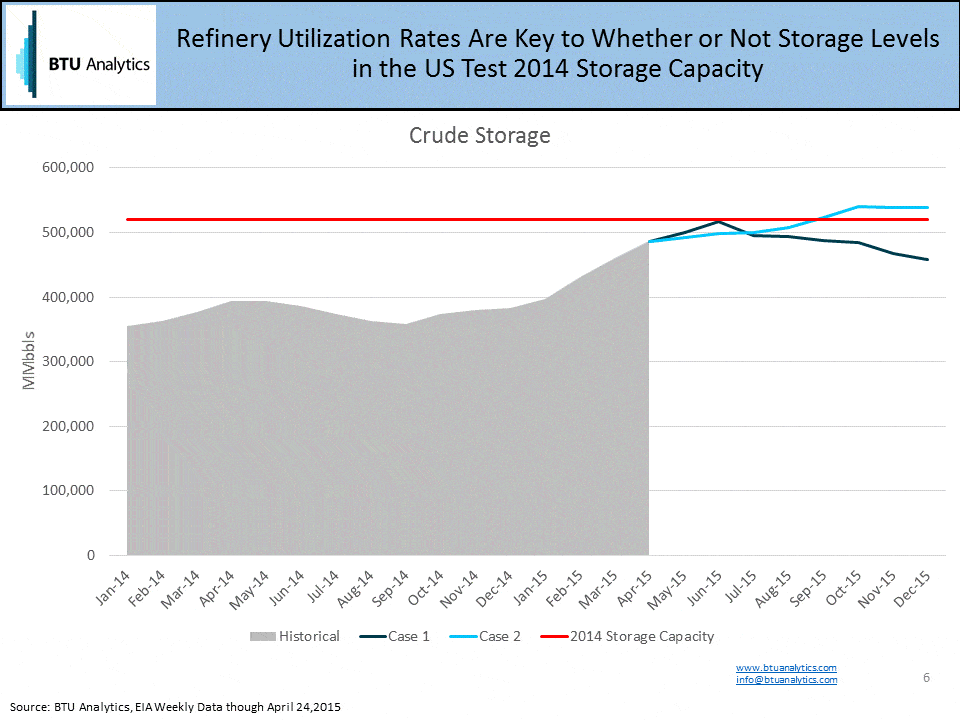Have prices bottomed? Can producers survive the fall 2015 refining shoulder season? While I do not have a crystal ball with all the answers – and if I did, you can bet I’d be on a boat sailing the world, drinking margaritas – in order to gain insight into pricing dynamics, BTU Analytics uses its proprietary crude oil production forecast and the EIA’s demand and storage data to establish a balance for the US crude oil market.

In the first four months of 2015, producers have been doing their best to conserve capital through decreased drilling activity and deferred completions. However, production is still higher today than it was in January as producers followed through on completing wells that were drilled as far back as six months prior. Some of the factors driving this lag between drilling and completions include the prevalence of pad drilling and access to pipeline capacity and other infrastructure. This has limited the impact of falling drilling activity on overall domestic crude production through the first four months of the year and helped drive record-breaking injection rates in February, March, and April. As a result, the market has been overrun with speculation about what happens if US crude storage capacity is reached. Due to higher refinery runs, lower storage builds in the last two weeks and a 3.9 MMbbl drawdown last week, the market has quieted regarding breaching capacity this spring. However, as we look forward more than one or two months, it still begs to question, how do prices fare during the fall maintenance season? After all, WTI is back above the $60/bbl mark and the lack of contango in the market does not incentivize continued deferral of completions.

In lieu of having a crystal ball, I have built two cases that arrive at two very different conclusions regarding storage utilization and therefore domestic crude prices. For both cases, I used BTU Analytics’ April 2015 production forecast. In order to estimate monthly imports for May through December 2015 I used imports seen from May to December 2014 since the US had already displaced essentially all of the light sweet imports into the US by that time, and further displacement opportunity through blending is not likely to swing the balance substantially without price incentive. Additionally, due to current crude oil export restrictions and a lack of incremental pipeline capacity connecting the US to Canada, exports are assumed to only grow marginally as increased volumes of stabilized condensate are exported.

Assuming production is set, the largest influencing factor for the US crude oil market is refining demand. I have developed two refining throughput cases to analyze the potential storage situations for the fall. Both cases have assumed that over 200 Mb/d of new refining capacity comes online between now and the next shoulder season as several new splitter and refinery projects are commissioned. Furthermore, using planned refinery outage data, 500 Mb/d and 700 Mb/d of planned outages in September and October, respectively, have been factored in. The largest contributors to these outages are Motiva’s Port Arthur, Marathon’s Catlettsburg, and Chevron’s Pascagoula refineries. In addition to planned outages, using historical 2014 unplanned outage data, I assumed that in any given month an additional 25% of unplanned outages will occur throughout the fall. After establishing a total operable capacity I examined historical refinery utilization rates to determine what refining throughput would be based on this operable capacity.


Case 1 assumes that monthly net utilization of operable capacity is the same for May to December 2015 as it was in 2014 and averages 92% for this period. Throughput volumes do increase due to the new splitter expansions expected to come online in the second half of the year. Case 2 uses a flat 90% average net utilization based on an average of 2014 net refinery utilization rates. This 2% difference in average utilization for the period results in significantly different refining demand forecasts.
In Case 1, the new refining capacity and smaller planned outages in the fall than the spring creates a short supply situation and storage volumes will likely see draws in the second half of the year to meet demand. Should this come to fruition, overall US storage levels would decrease, but could still exit higher than January 2015 levels. While it could take into 2016 to draw down storage levels to more historic norms, in this case, WTI would strengthen and the spread to Brent would tighten significantly to attract imports or incentivize producers to grow production in 2016. A strengthening in WTI would likely not be enough to slow down refinery runs significantly as prices would still be in the $65-$70 range, but will hurt refining margins.

In Case 2, refineries on average run at a 2% lower utilization rate, averaging 90% net utilization of operable capacity, resulting in a drastically different story. Lowering utilization by 2% means that, on average, refining demand is 300 Mb/d lower between May and December than in Case 1, leaving 2.4 MMbbls of extra supply in the market over this eight month period. This results in a significant storage build throughout the remainder of the year and storage volumes will test US storage capacity published in the EIA’s September 2014 report.

If storage injections continue throughout the year and storage capacity limits are tested, then WTI prices will likely test lows seen this winter. While WTI prices could weaken, prolonging the slowdown in E&P activity, Brent pricing could remain strong as global demand continues to increase widening the WTI-Brent spread. The spread between WTI and Brent would have to widen enough to incentivize displacement of remaining crude oil imports through blending and refinery substitution of light for intermediates and heavy grades.
After months of record-breaking storage, paired with BTU Analytics’ production outlook, and a generally bearish outlook on crude oil prices for 2015, I was surprised to see that I was able to build a plausible case where storage levels did not blow through the roof this fall when refineries go into maintenance – providing a ray of hope to producers that prices won’t crater again this fall. My analysis illustrates that the US oil market remains balanced on a knife’s edge. Higher than expected refinery outages or higher US production from deferred completions, decreased well costs, and high-grading could lead to a drastically oversupplied market in the fall, sending prices tumbling. Conversely, if refiners continue to eek out record-breaking utilization rates, then we could see prices show some resilience.








